Mexico is a top destination for visiting Mayan ruins. From before 1,000 BC, ancient Mesoamerican civilizations, including the Maya, built magnificent cities all across Mexico.
Amazingly, many of these sites are still incredibly well-preserved, making for a truly memorable travel experience!
The Mayan archaeological sites have unique settings (from coastal perches to jungle hideaways), and no matter which ruins in Mexico you decide to visit, you’ll gain insight into these ancient civilizations, while being in awe of the architecture.
In particular, the Yucatan has a wealth of Mayan sites to visit.
Together with my husband, we travelled extensively around this region of Mexico, visiting many of these incredible sites along the way — our favourites being Coba, Tulum, and Chichen-Itza.
But, there are many more Mayan ruins to discover.
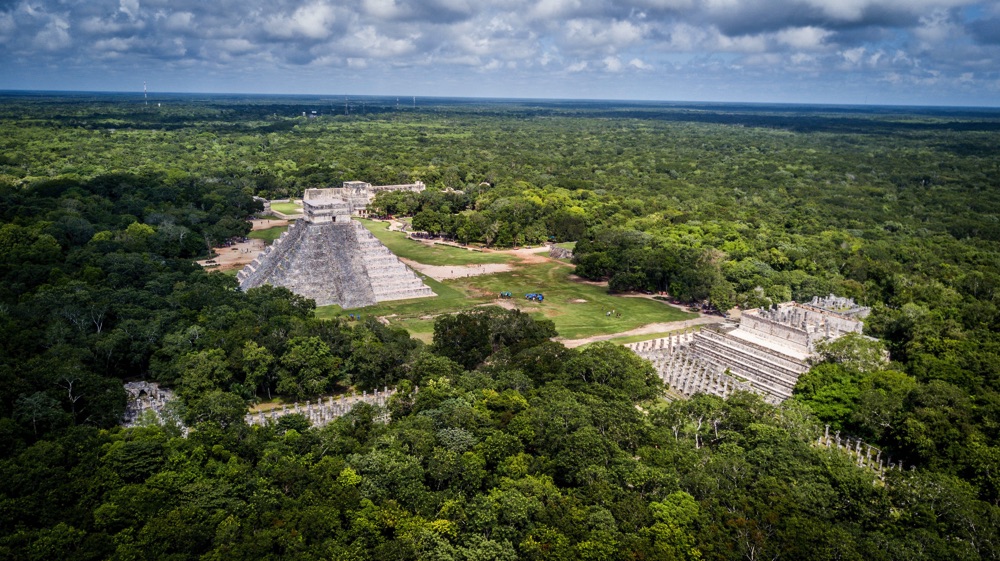
During your trip to Mexico, leave the gorgeous Yucatan beaches behind and enjoy a day of exploration!
Here are the top 10 Mayan ruins in Mexico you won’t want to miss.
1. Tulum Ruins
The Tulum ruins have a spectacular and incredibly photogenic cliff-top setting overlooking the turquoise waters of the Caribbean Sea.
Interestingly, Tulum is the only Mayan city built on the coast. The name Tulum means “wall” and these ruins are also a rare example of a walled Mayan city.
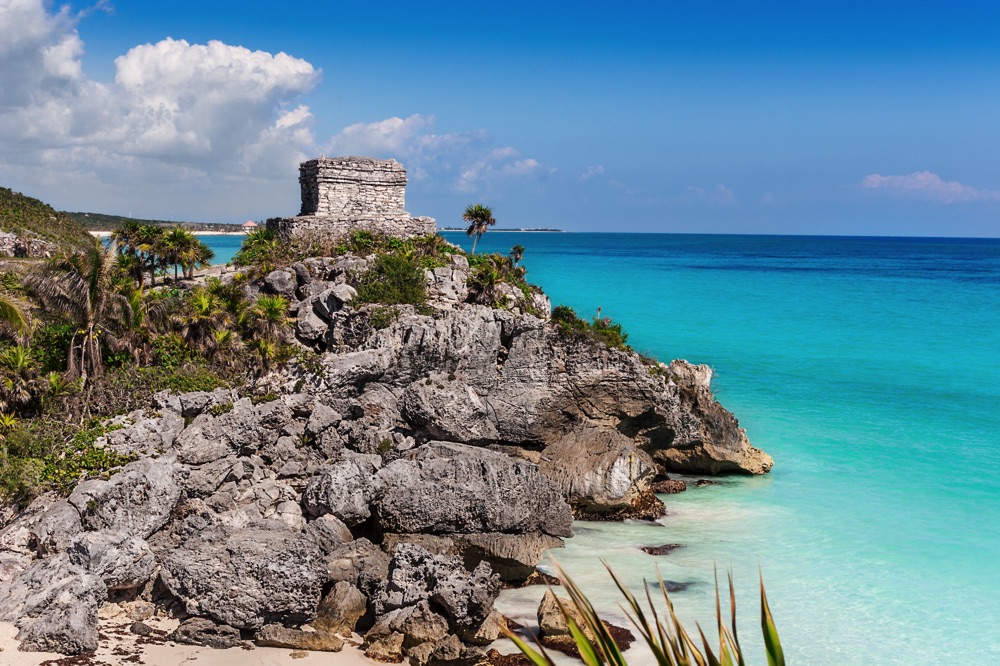
History and Significance of Tulum Ruins
Historically, Tulum was built as a fortress to protect its role as a seaport.
During the 13th and 15th centuries, this Mayan city served as a powerful trading post. It connected nearby communities via sea and land with those further afield in Central America.
The main pyramid in Tulum (El Castillo) was a lighthouse that safely guided small boats through the coral reef barrier with their precious cargoes of obsidian and jade.
Why Visit Tulum Ruins?
In addition to its stunning coastal location, enormous iguanas roam freely around the ancient Mayan ruins. This makes perfect photo opportunities against the tantalizing backdrop of the Caribbean Sea.
Once you’ve finished exploring, climb down to Paradise Beach and enjoy a refreshing swim! This is one of the top places to see in Mexico, and for good reason.
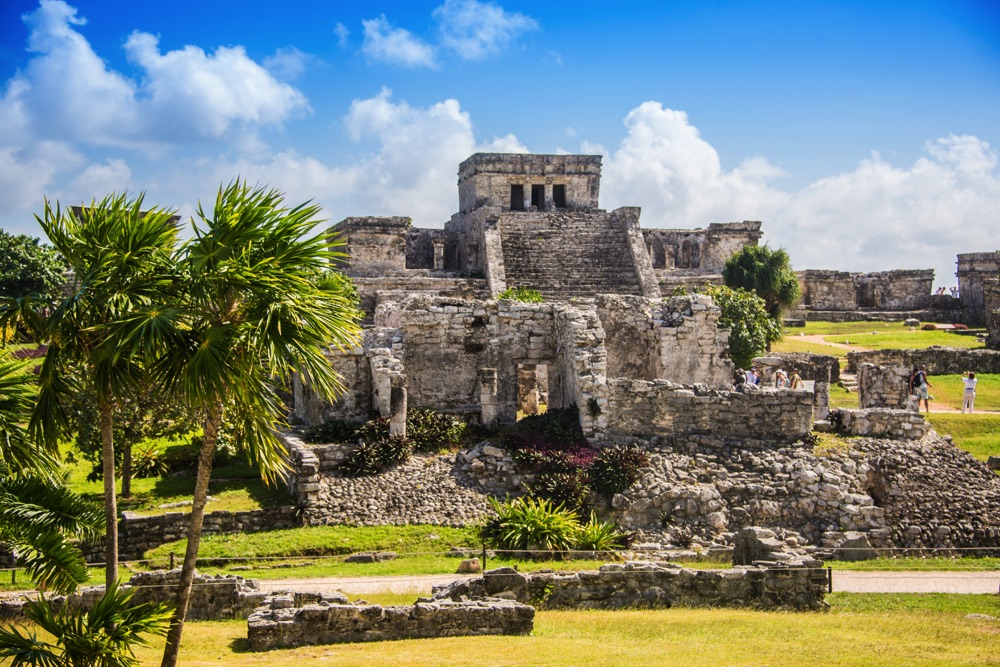
Transportation and Entrance Fees
The Tulum ruins are found along the Riviera Maya on the eastern coast of the Yucatan peninsula in the state of Quintana Roo.
The ruins are located just outside the small town of Tulum which is approximately 130 km (1h 40 mins) south of Cancun. You can reach the ruins easily by car from Cancun or Playa del Carmen via Highway 307 which runs along the Riviera Maya.
You can take public transport by using either the first-class ADO bus service or the second-class Mayeb buses. Our preferred choice was travelling by shared colectivo.
Another option is to visit on a tour, which includes transportation, entrance fees, and guide. This eco-friendly tour also includes a visit to Dos Ojos, which is one of the top cenotes in the area. Click here for details.
The Tulum ruins are open daily from 08:00-17:00.
The entrance fee is 80 Mexican Pesos ($3.20) for adults and children under 13 are free. There is a small charge if you want to use your camera.
From the entrance, it’s a 10-15 minute walk to the ruins, or you can take a small train if you prefer.
 Click here to find the Tulum Ruins on the map.
Click here to find the Tulum Ruins on the map.
2. Uxmal Ruins
The Mayan ruins at Uxmal are perhaps some of the most attractive to visit. This UNESCO World Heritage Site also has far fewer visitors than other Mayan ruins in Mexico.
A highlight is that you can still climb some of the ancient structures at Uxmal. This adds a real sense of adventure to your visit!

History and Significance of Uxmal Ruins
Historically, Uxmal was the most famous and powerful of all the Mayan cities with 20,000 inhabitants at its peak.
It served as an important religious centre as well as being the economic and political headquarters of the entire region.
The name of the city means “three times built” alluding to Uxmal’s development between the 7th and 9th centuries. Built in Puuc style, the ancient buildings of Uxmal were designed by astronomy rather than geometry.
However, legend has it that a magic dwarf built the 35 meter high Pyramid of the Magician! Whatever the truth, this pyramid is a well-preserved example of the smooth, curved Puuc design.
Why Visit Uxmal Ruins?
Although you cannot climb the Pyramid of the Magician, don’t miss out on climbing the Great Pyramid.
From the top, you will enjoy stunning views of the area and get a good sense of the layout of this Mayan city.
At Uxmal, you can also marvel at the ball court where the Mayan played the traditional game of tlachtli — which often ended in human sacrifice for the losing team!
Transportation and Entrance Fees
If you want to visit Uxmal, it is best to stay in Merida.
If you’re driving, the ruins are located 80 km (1 hour) south of this city just off Highway 261. You can also reach Uxmal via a second-class bus from Merida.
Another option is to visit on a day tour from Merida.
This trip takes you to both the Mayan ruins of Uxmal, and the Puuc style city of Kabah. Plus, it includes lunch, round trip transportation and a guide. Click here for details.
The Uxmal ruins are open daily from 08:00-17:00 and the entrance fee is 418 Mexican Pesos ($16.75).
 Click here to find the Uxmal ruins on the map.
Click here to find the Uxmal ruins on the map.
3. Coba Ruins (Mayan ruins in Mexico you can climb)
Without a doubt, the Coba ruins are my personal favourite.
The untouched jungle setting instantly transports you back thousands of years.
As you whizz along the white stone sacbes (paths) on rented bicycles, hidden Mayan ruins suddenly rise out of the undergrowth.

History and Significance of Coba Ruins
The Coba ruins are the least excavated of the Mayan ruins of Mexico with over 5,000 mounds still undiscovered.
When you visit Coba, you can definitely sense the deep history and age of the Peten style buildings which were first inhabited in 100 AD.
At its peak, 50,000 people lived in this enormous city. It sprawled over 80 square kilometers and had over 6,500 temples.
Coba means “waters stirred by wind” which refers to the city’s location next to four natural lakes (a rare phenomenon in the Yucatan).
Over time, Coba became a significant agricultural and trade centre thanks to its unusual network of 45 roads (sacbes).
One road discovered was 100 km long (linking Coba to Yaxuna near Chichen-Itza) which enabled the transport of goods over long distances.
Why Visit Coba Ruins?
No visit to Coba is complete without renting a bicycle and exploring this untamed site via the 16 sacbes open to the public.
However, another highlight for visitors is climbing the remains of Nohoch Mul, one of the highest temples in the Mayan world!
At 42 m high, Nohoch Mul dominates the surrounding landscape.
The view from the top over the jungle canopy is literally breath-taking! Take care when climbing the 120 worn and uneven steps and use the rope to descend as this is more challenging than the ascent.
In addition to its crumbling temples, Coba has two well-preserved ball courts.
The site is also considerably less touristic than some of the other Mayan ruins. A visit to Coba is certainly an authentic adventure in a natural setting surrounded by the sounds of the wild!
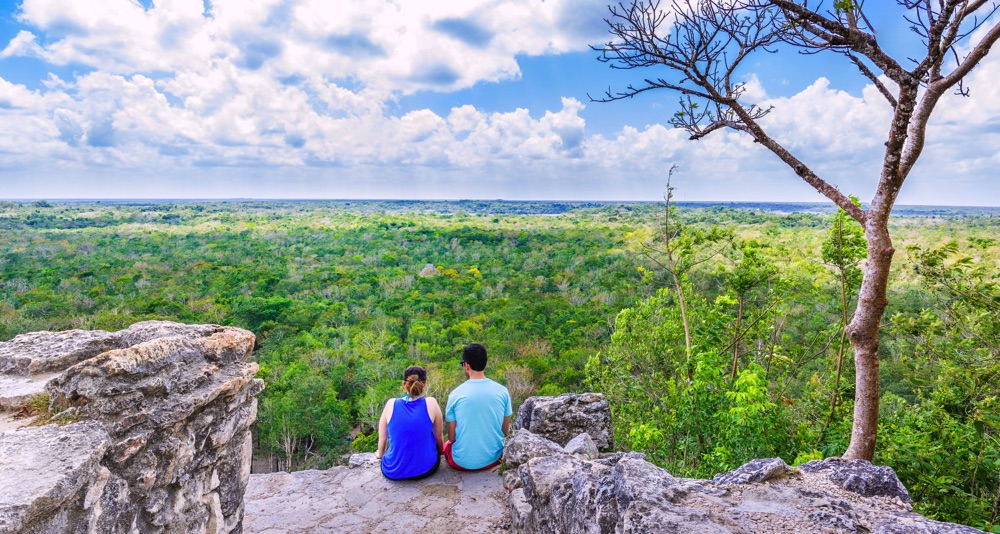
Transportation and Entrance Fees
Coba is located in the state of Quintana Roo on the Yucatan peninsula. It can be accessed by road from most major resorts in the region.
It’s 132 km (2.5 hours) from Cancun, 109 km (1.5 hours) from Playa del Carmen, 110 km (1.5 hours) from Chichen-Itza and 48 km (45 minutes) from Tulum.
ADO buses also serve Coba from Cancun, Playa del Carmen and Tulum.
You can book a day trip to visit the Coba ruins from Cancun, Playa del Carmen, and Tulum.
Each of those tours generally includes the same things — round trip transportation, entrance fees, and guide. Some of them include lunch as well. Click here to see the various tours on offer (including reviews and costs).
The entrance fee to the Coba ruins is 80 Mexican Pesos ($3.20) with a parking charge of 50 Mexican Pesos ($2). You can hire a bicycle for 50 Mexican Pesos ($2) or sit back and let a guide do all the hard work in a shared bicycle taxi!
Coba ruins are open daily from 08:00-17:00. If you plan to stay overnight (as we did), book in advance as accommodation is limited.
 Click here to find Coba Ruins on the map.
Click here to find Coba Ruins on the map.
4. Chichen-Itza Ruins
Amongst the incredibly well-preserved, impressive ruins of Chichen-Itza, is one of the 7 New Wonders of the World. This is the awe-inspiring El Castillo or Kukulkan Pyramid.
You can also marvel at the largest surviving tlachtli ball court which is an impressive 168 meters in length. Close your eyes and try to imagine the scene 1,000 years ago!
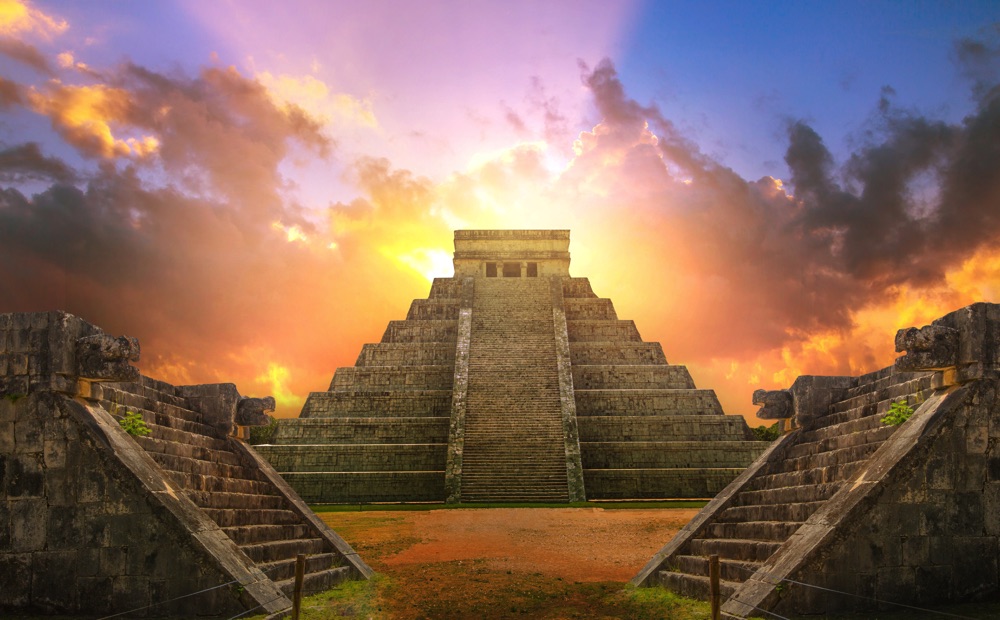
History and Significance of Chichen-Itza Ruins
Founded in the 6th century, this Mayan city built in Puuc style flourished between 900-1300 AD.
The city’s name means “at the mouth of the well of Itza”, which refers to the underground rivers and two cenotes found within the complex.
Chichen-Itza was perfectly positioned by the Maya around a fresh supply of water.
Chichen-Itza became one of the largest cities in the Mayan world covering approximately 5 square kilometers with 50,000 inhabitants.
It was an important political and economic centre and eventually became a powerful regional capital.
Its Mayan rulers controlled much of the Yucatan peninsula, trading gold and other precious goods via the city’s port at Isla Cerritos on the northern coast.
Why Visit Chichen-Itza Ruins?
The UNESCO World Heritage Site of Chichen-Itza is undoubtedly one of the best-preserved examples of Mayan ruins that we visited.
Although you cannot climb the 24 meter high El Castillo (or any other structures), it’s a fascinating piece of architecture that gives you insight into Mayan beliefs.
Built as a square-based pyramid facing the cardinal points of the compass, El Castillo has 4 sides.
Each side has 91 stairs, but including the crowning platform, there are 365 steps in total.
These exactly match the number of days in a solar calendar year!
If you time your visit right, you may even see the descending shadow of the feathered serpent deity of Kukulkan.
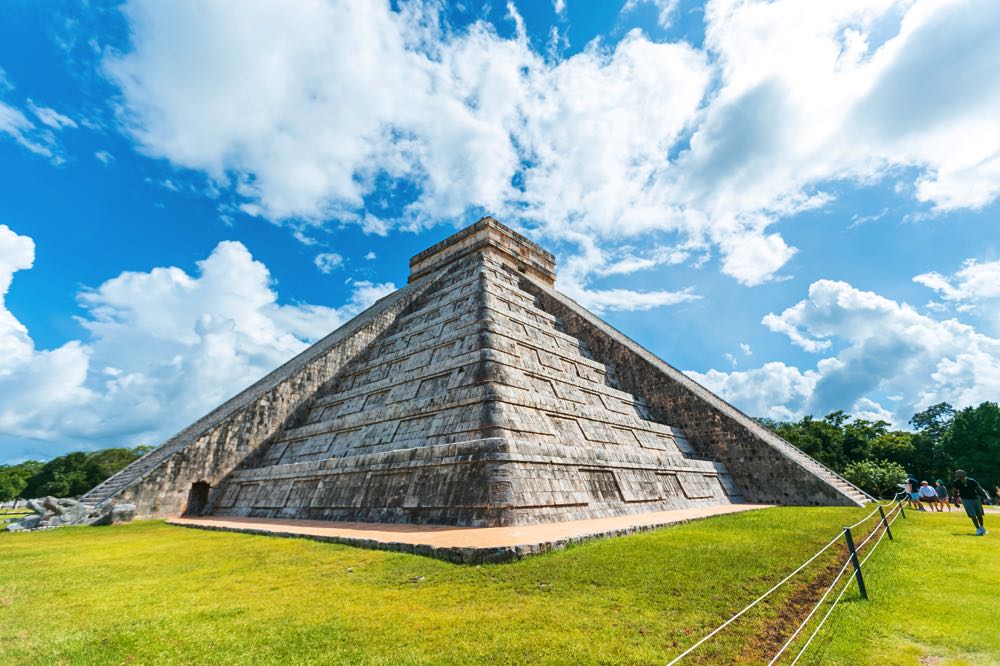
Transportation and Entrance Fees
Although Chichen-Itza is extremely popular with tourists and has an extensive number of on-site vendors, no visit to the Yucatan would be complete without a visit here.
The site is situated in the eastern part of the state of Yucatan, 120 km (2 hours) west of Cancun, 120 km (2 hours) east of Uxmal and 120 km (1.5 hours) east of Merida.
This highly-rated day tour to Chichen Itza includes round-trip transportation (pick up from your hotel), lunch, a visit to Valladolid and swimming at the Ik Kil cenote. Click here for details.
An alternative to travelling by car or bus is to fly by small plane or helicopter from Cancun.
Chichen-Itza is open daily from 08:00-17:00 and the entrance fee is 486 Mexican Pesos ($20.50).
When we visited, tripods and drones were forbidden. However, there are lockers where you can leave your equipment. Whilst you are visiting Chichen-Itza, we also highly recommend a refreshing swim in the nearby beautiful cenote, Ik Kil.
 Click here to find Chichen Itza on the map.
Click here to find Chichen Itza on the map.
5. Ek Balam Ruins
If you want to escape the crowds, the dense jungle setting of the Ek Balam ruins could be the perfect choice for you.
Discovered in the 1980s, these ruins are lesser-known than Chichen-Itza so are uncrowded and can be explored in peace.
Like Coba and Uxmal, you can also still climb some of the ancient structures.
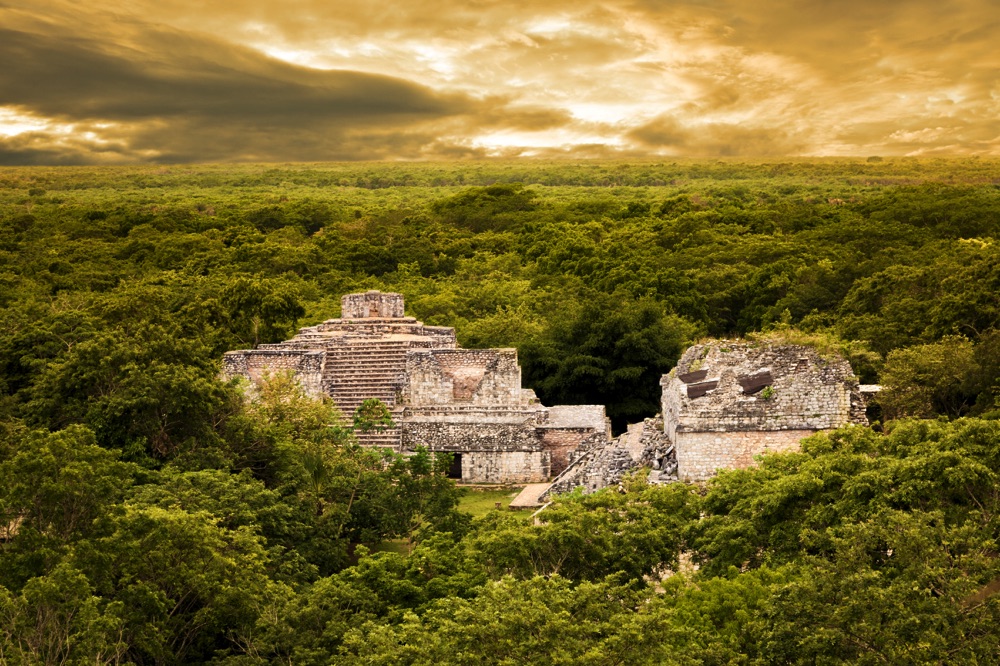
History and Significance of Ek Balam Ruins
The Maya lived in the city of Ek Balam between 600 BC and 1600 AD.
Although the site covers 15 square kilometers, only the walled city centre has been excavated which is the part you can visit today.
Two concentric walls (2 meters tall and 3 meters wide) surround the 40 structures of Ek Balam.
At its peak (700 to 900 AD), Ek Balam was a powerful city of 18,000 inhabitants that controlled much of the northern Yucatan.
In fact, the name Ek Balam means “Black Jaguar” which is a Mayan symbol of power, fierceness and bravery.
The site contains many temples (confirming its role as a religious centre), two huge palaces and the Acropolis also known as La Torre (the Tower).
Why Visit Ek Balam Ruins?
The main attraction for visitors to Ek Balam is definitely the Acropolis Pyramid which is 31 meters high, 160 meters long and 70 meters wide.
After climbing the 106 steps to the top, you will be rewarded with a dizzying 360-degree panoramic view over the thick jungle canopy and may even see Coba and Chichen-Itza on a clear day!
At Ek Balam, you will also find well-preserved Mayan sculptures of jaguars and winged warriors.
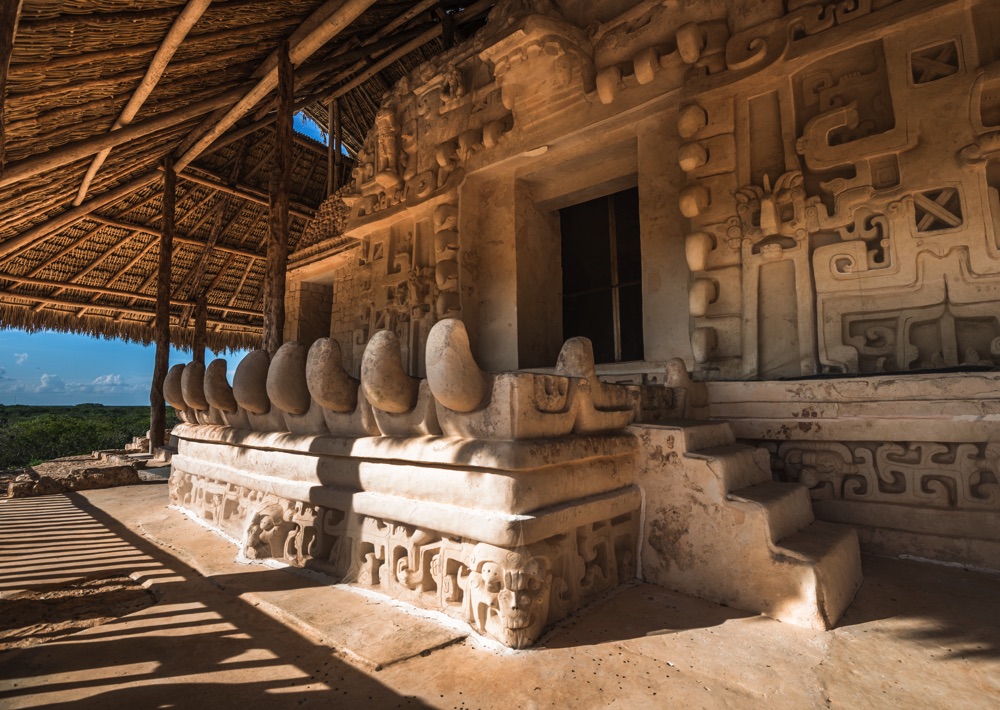
Transportation and Entrance Fees
The Ek Balam ruins are located in the state of Yucatan just 30 km (30 minutes) north of Valladolid, 68 km (1 hour) northeast of Chichen-Itza and 170 km (2 hours) southwest of Cancun.
It’s best to base yourself in Valladolid, but many people visit Ek Balam on a day trip from the coastal cities.
From Valladolid, you can reach the Ek Balam ruins by car or by sharing a colectivo which you can find parked along Calle 44 between Calles 35 and 37.
If you’re based in Cancun, check out this tour which includes Chichen-Itza as well. Plus, round trip transport, breakfast, lunch, and a guide are all included.
The entrance fee is 413 Mexican Pesos ($16.50).
 Click here to find Ek Balam on the map.
Click here to find Ek Balam on the map.
6. Palenque Ruins
Palenque is perhaps the most studied and documented of all the Mayan archaeological ruins.
Undoubtedly, a visit to the Palenque ruins is a rich architectural and historical experience. The tranquil location of these ruins also overlooks the dense jungle in the foothills of the Tumbala mountains.
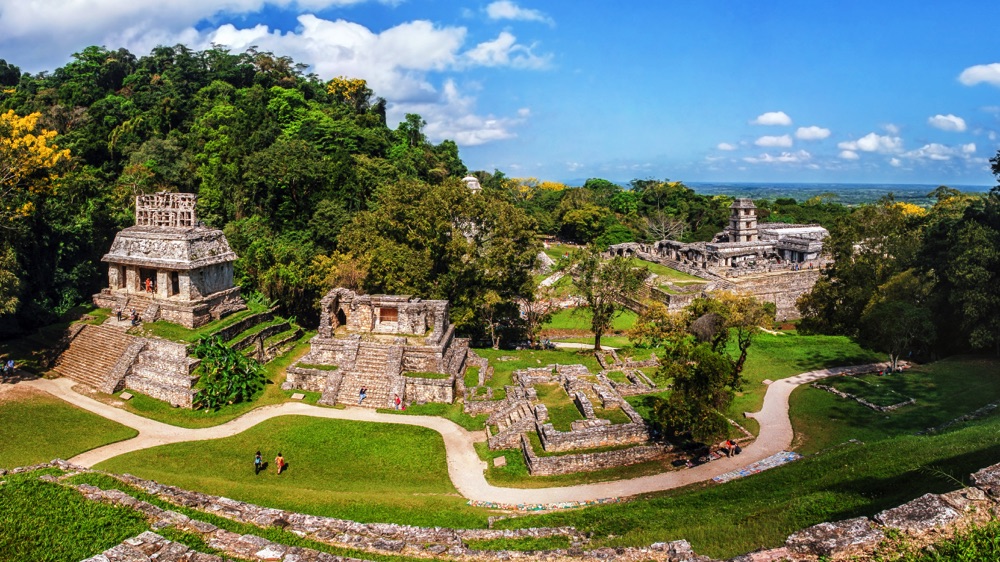
History and Significance of Palenque Ruins
Palenque was smaller than other Mayan cities with 6,220 inhabitants at its peak. However, it was as important as Chichen-Itza.
The city dates back to 226 BC and has 1,400 buildings.
Hieroglyphics and inscriptions found in the Temple of Inscriptions and elsewhere on the site have revealed lost Mayan stories and new historical facts.
Less than 10% of Palenque has been excavated, but archaeological findings show that it was an important inland trade and political centre for the Maya.
Cedar, Mahogany and Sapodilla trees surrounded Palenque which was built near the Usumacinta River.
This became an integral part of the settlement. Pressurized canals of up to 50 meters in length fed water into the city and served as a means of transport for the inhabitants of Palenque.
Why Visit Palenque Ruins?
The architectural and historical magnificence of Palenque is recognized by UNESCO. Of course, most World Heritage Sites are a must-see on any visitor’s bucket list.
The natural setting of Palenque nestled above misty jungles adds to its unique atmosphere.
At Palenque, you will certainly experience the harmony of nature, architecture, and history.
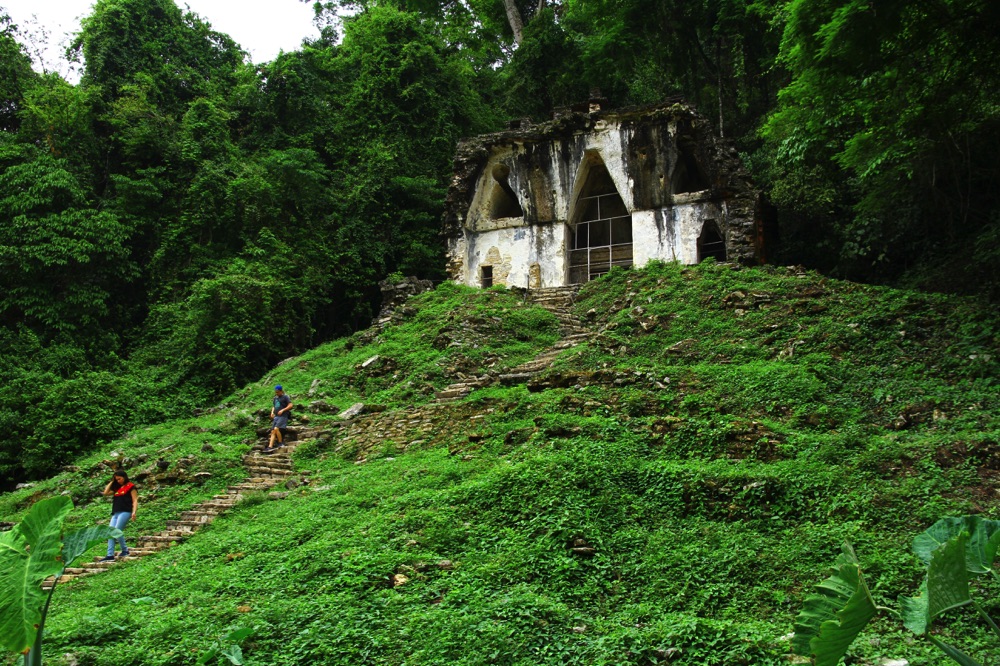
Transportation and Entrance Fees
Palenque is situated in the northern part of the Chiapas state in southern Mexico. You can reach Palenque by road via car or bus and the entrance fee is 80 Mexican Pesos ($3.20).
However, these ruins are relatively remote so you will need to plan your route carefully.
The Palenque ruins are located 360 km (4.5 hours) south of Campeche and 144 km (2 hours) east of Villahermosa which has an international airport. Alternatively, there are flights from Mexico City airport to Palenque airport.
 Click here to find Palenque on the map.
Click here to find Palenque on the map.
7. Monte Alban
If you are keen to learn about a different ancient civilization, consider a visit to the Monte Alban ruins.
Instead of learning about the Mayan world, this UNESCO World Heritage Site will immerse you in the culture of the Zapotecs — another ancient Mesoamerican civilization based in the Mexican valley of Oaxaca.

History and Significance of Monte Alban Ruins
The Monte Alban ruins are one of the oldest Mexican cities dating back to 500 BC.
Although only 10% of the site has been excavated so far, approximately 35,000 people lived here during the city’s peak between 200-600 AD.
Incredibly, the city of Monte Alban was inhabited for over 1,500 years.
For much of that time, Monte Alban was an important political and economic centre and eventually, it became the capital of the region.
As one of the largest and most important cities in Mesoamerica, Monte Alban had a form of government with far-reaching political influence.
Why Visit Monte Alban Ruins?
For travellers, this important archaeological site also has a unique setting.
The city of Monte Alban was carved out of a low mountain range which sits 400 meters above a valley. From the site, you can enjoy beautiful views of the surrounding landscape.
Monte Alban is less popular than other ruins in Mexico, meaning it’s less crowded. However, there are many structures to explore.
These include the imposing Gran Plaza measuring 300 x 200 meters, truncated pyramids, a ball court, observatory, underground passageways, and 170 tombs.
In addition, you will find hundreds of petroglyphs (rock carvings) hidden among the stones.
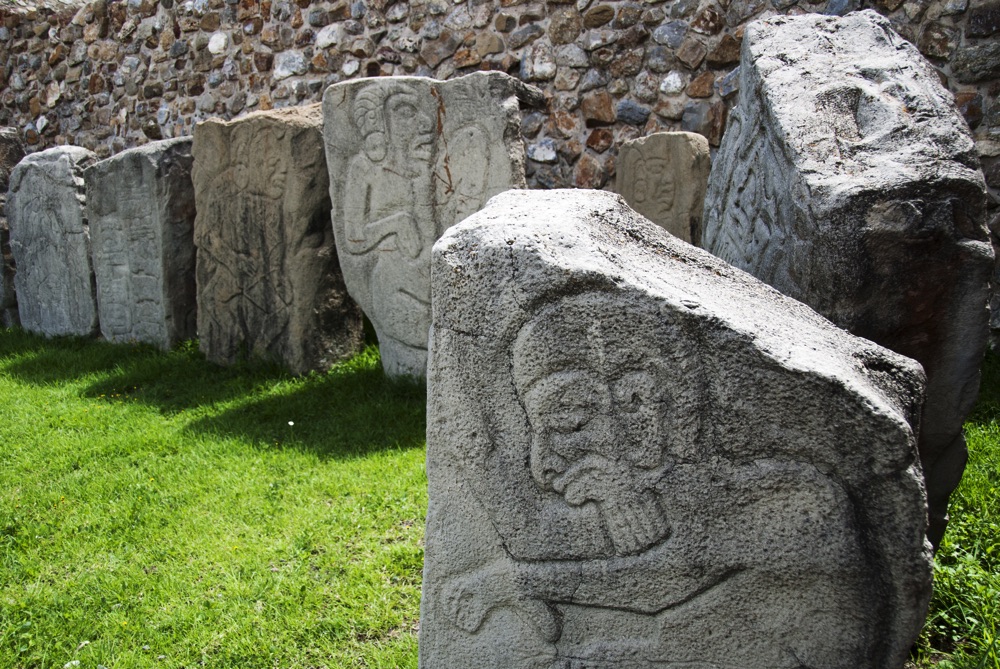
Transportation and Entrance Fees
The Monte Alban ruins are situated in Oaxaca state which is in southern Mexico. The easiest way to reach the site is by car, taxi or a tourist shuttle bus (45-minute drive) from Oaxaca City (10 km east of Monte Alban).
The nearest bus stop to Monte Alban is still a 45-minute walk from the ruins.
Alternatively, you can join a half-day trip from Oaxaca City, which will take you to the Monte Alban ruins and includes a knowledgable guide, entrance fees, round trip transport from your hotel and drinks. Click here for details.
Monte Alban is open from 08:00 to 16:30. The entrance fee is 70 Mexican Pesos ($2.80).
 Click here to find Monte Alban ruins on the map.
Click here to find Monte Alban ruins on the map.
8. Teotihuacan
Even today, the identity of the ancient builders of Teotihuacan remains unknown.
This ancient Mesoamerican city was huge with an estimated population of 200,000 people!
A visit to this mysterious site will leave you marveling at its enormous structures as you climb in the ancient footsteps of past citizens.
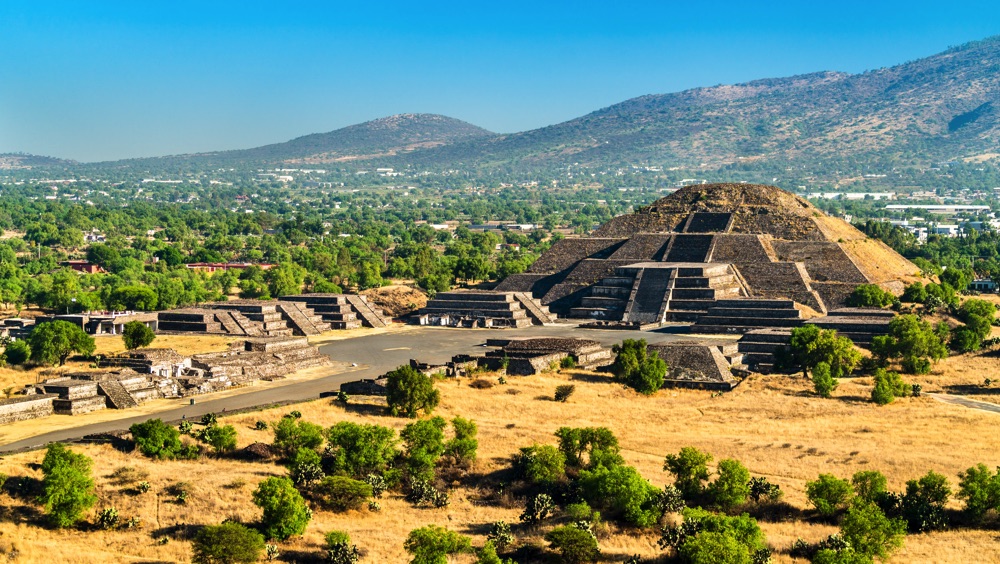
History and Significance of Teotihuacan Ruins
Although Teotihuacan dates back to 400 BC, the Aztecs found this abandoned city in 1400 AD and named it “the place where the gods were created”.
The city sprawls over 20 square kilometers and has a grid layout of single-story buildings, pyramids, plazas, temples, and palaces.
Even though the origins, history, and culture of Teotihuacan are still mainly shrouded in mystery, archaeologists discovered that the city was a wealthy trade centre.
It exported finely crafted obsidian tools and ceramics, and in fact, Teotihuacan had a huge influence on art and architecture throughout Mesoamerica.
Ritual sacrifices of animals and people were also widely practiced here.
Why Visit Teotihuacan Ruins?
Like many of the best ruins in Mexico, Teotihuacan is a UNESCO World Heritage Site with many fascinating and well-preserved structures to explore.
The importance of astronomy and geometry is visible in the architecture at Teotihuacan.
Intriguingly, The Avenue of the Dead is a 2.4 km long road that points directly to the sacred peak of an extinct volcano, Cerro Gordo.
You can still climb the 250 steps to the top of the 66 m high Pyramid of the Sun. This is the tallest structure on the site and one of the tallest in Mexico.
As you can imagine, the view from the top is magnificent!
Other highlights for visitors include The Pyramid of the Moon (43 m high), The Citadel and The Temple of Quetzalcoatl —a truncated pyramid built in honour of the feathered serpent deity.
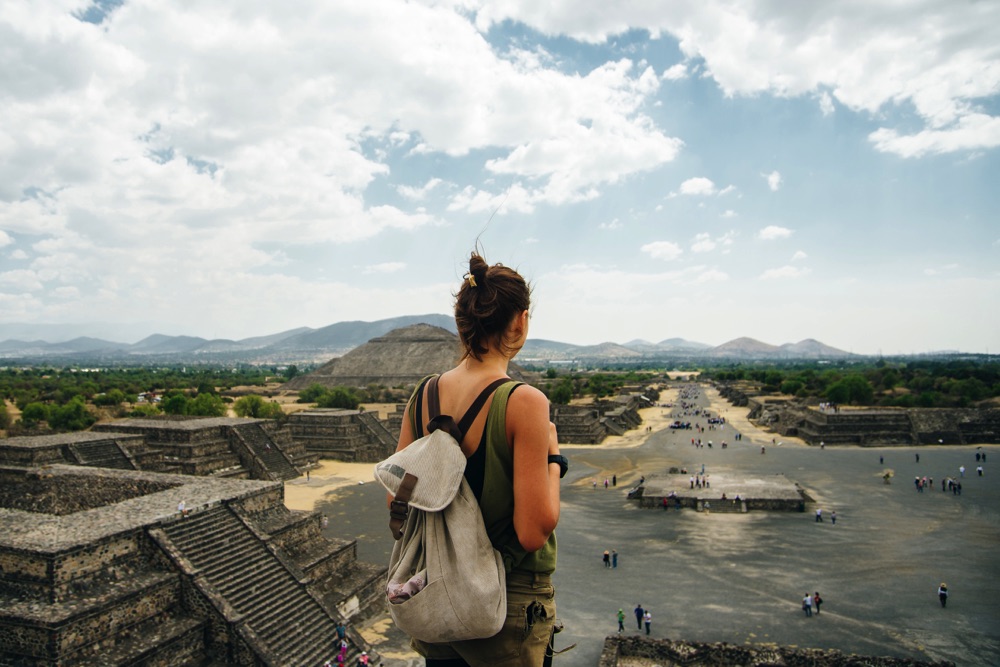
Transportation and Entrance Fees
Teotihuacan is located 50 km (50 minutes) northeast of the capital. You can reach this archaeological site by car, taxi, or day tour from Mexico City.
This tour allows for early access to the site, meaning you’ll have Teotihuacan basically to yourself. A guide and transport. (from the meeting point, not your hotel) are also included. At $35/person, it’s an affordable option.
Alternatively, this full-day tour of Teotihuacan includes stops at Tres Culturas and the Shrine of Guadalupe. Lunch is not included, but pick-up from most hotels are. At $33.60/person, it’s another affordable tour option.
You can also use public transport by taking the metro to the Autobuses del Norte metro station, then a bus to Teotihuacan.
The ruins are open from 09:00-17:00 and the entrance fee is 80 Mexican Pesos ($3.20).
 Click here to find Teotihuacan on the map.
Click here to find Teotihuacan on the map.
9. Dzibilchaltun Ruins
Although there are no large pyramids here, the Dzibilchaltun ruins offer a fascinating insight into the Maya’s understanding of astronomy and mathematics.
Here, you can also swim in the lily-covered crystal-clear waters of the Cenote Xlacah located within the archaeological site. It’s 44 meters deep and features an underground cave.

History and Significance of Dzibilchaltun Ruins
Dzibilchaltun was first inhabited around 500 BC and is one of the oldest Mayan cities on the Yucatan peninsula.
Over time, it became a significant Mayan city with 40,000 inhabitants and 8,400 buildings!
The name Dzibilchaltun means “place where there is writing on the stones”. This relates to the many commemorative tombstones (stelae) found on the site.
For the Maya, Dzibilchaltun was a wealthy port and an important centre for coastal trade.
The city’s close proximity to the Gulf of Mexico enabled trade to flourish in marine products including salt and fish. However, Dzibilchaltun also benefited from agricultural trade.
Why Visit Dzibilchaltun Ruins?
The main attraction at the Dzibilchaltun ruins is the Temple of the Seven Dolls (or Temple of the Sun) which is a striking building with a tower on a pyramid base.
The name of the temple is from the offering of human-form clay figures found buried here.
During the Spring and Autumn equinoxes, the sun aligns precisely with the temple door and illuminates the opening.
This archaeological site also has a large plaza, 12 sacbes, and The Open Chapel which unusually survived Spanish occupation.
There’s also a museum which documents the interesting Maya and Spanish history of Dzibilchaltun.
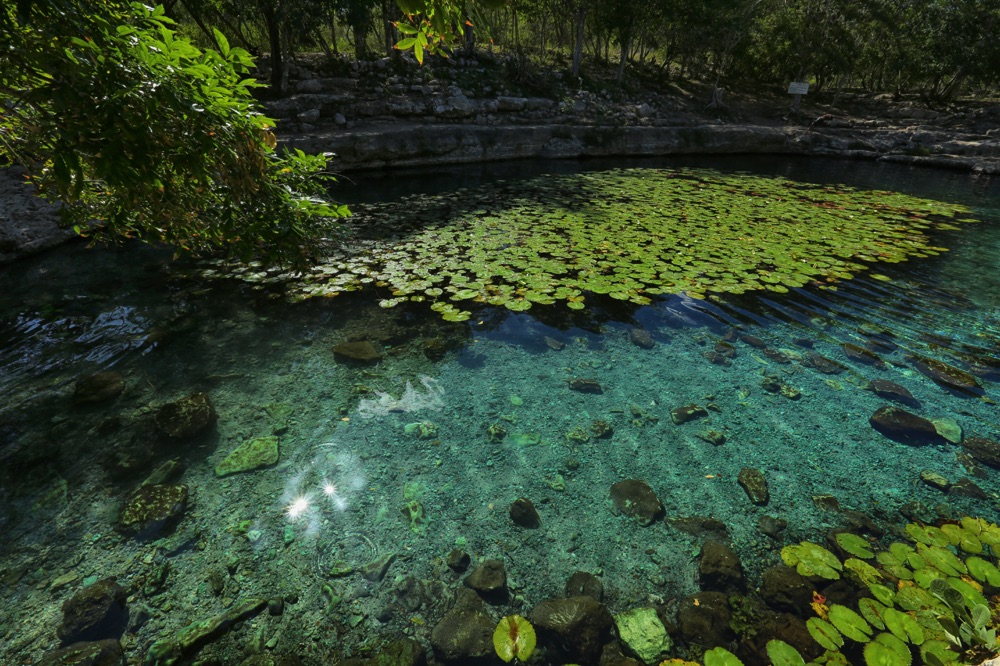
Transportation and Entrance Fees
The Dzibilchaltun ruins are located on the northern coast of the Yucatan peninsula about 28 km (30 minutes) north of Merida.
You can access them by car, taxi, public transport, or day trip from Merida.
Alternatively, colectivos offer a cheaper option. You can wait at Calle 69 between 62 and 64 San Juan Park in Merida.
Entrance to this archaeological site costs 227 Mexican Pesos ($9.60) and opening times are 08:00-17:00.
 Click here to find Dzibilchaltun ruins on the map.
Click here to find Dzibilchaltun ruins on the map.
10. Calakmul Ruins
A visit to the Calakmul ruins will not disappoint.
Like Coba and Palenque, this lost ancient city is set in the remote seclusion of a deep dense jungle. A visit to Calakmul is certainly an adventure!
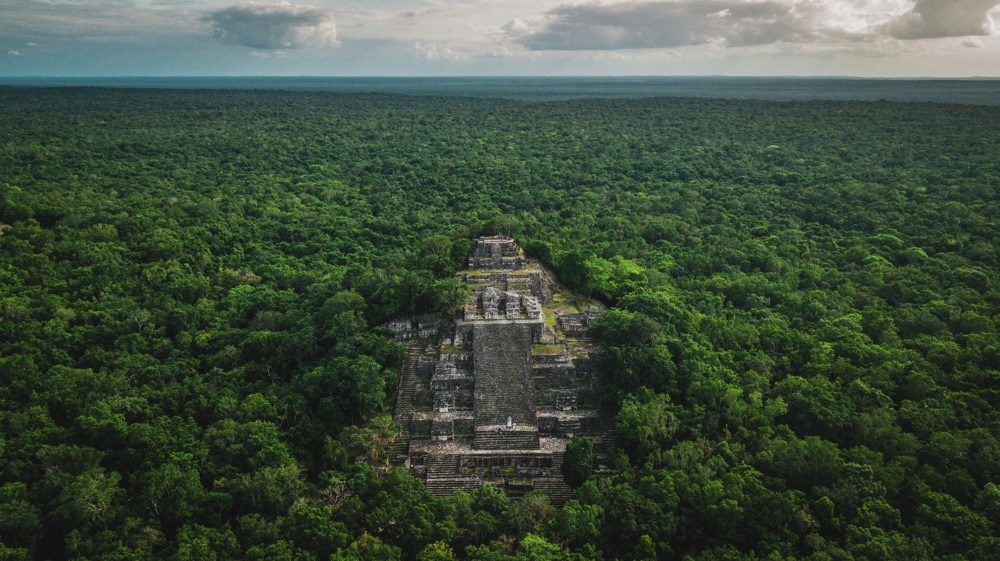
History and Significance of Calakmul Ruins
Calakmul is another early example of an enormous Mayan city. Between 500 BC and 900 AD, 50,000 inhabitants lived on this site which measures 70 square kilometers.
Archaeologists have discovered 6,700 structures in Peten style and many sacbes.
Calakmul was one of the largest and most powerful Maya settlements and was known as the Kingdom of the Snake.
Given its power, the city was in frequent conflict with Tikal (located in modern-day Guatemala) and its allies. The site of Calakmul is just 35 km from the Guatemalan border.
Why Visit Calakmul Ruins?
In addition to Calakmul being a UNESCO World Heritage Site, the surrounding tropical forests of Tierras Bajas are a protected UNESCO Biosphere.
This remote setting is located 60 km from the highway. A visit to Calakmul will immerse you in Mayan culture, history and nature.
Calakmul’s peaceful and remote setting offers visitors a unique opportunity to enjoy the sights and sounds of the jungle. Toucans, howler and spider monkeys can be frequently sighted here — you might even spot a jaguar!
The name Calakmul means “city of the two adjacent pyramids”. Another highlight of visiting Calakmul is that you can still climb the 45 meter high Great Pyramid.
The view from the top over the jungle canopy is stunning. Take your time and enjoy the symphony below you.

Transportation and Entrance Fees
Calakmul is located in the Yucatan state of Campeche. However, it’s 303 km (5 hours) south of the city of Campeche.
A good place to break your journey by road is Xpujil which is 116 km (2 hours) from the site of Calakmul. ADO buses connect Campeche to Xpujil once a day.
The Calakmul ruins open daily from 08:00-17:00 and cost 188 Mexican Pesos ($7.50) to visit.
Be ready to pay your entrance fee in 3 parts: 50 Mexican Pesos by the main road, 68 Mexican Pesos at the gates to the National Park and 70 Mexican Pesos at the archaeological site.
 Click here to find Calakmul on the map.
Click here to find Calakmul on the map.
Final Advice for Visiting the Mayan Archeological Sites in Mexico
To make the most of your visit to any of the ruins, I advise you to arrive early in the morning or later in the afternoon to avoid the crowds.
Try and avoid visiting on Sundays, as there is free entry to many archaeological sites for Mexican citizens — meaning the sites could be packed.
The heat at some of the sites (especially Chichen-Itza and Tulum) can be intense and there is very little shade. Make sure you cover your shoulders and take a hat, small fan, water, and plenty of sunscreen.
Other ruins are located in dense jungle, so it is worth considering wearing long trousers and applying mosquito repellent. In the wet season, a raincoat is also a good idea.
Given the size and nature of these archaeological sites, make sure you wear practical footwear for comfort and support if climbing uneven and worn steps.
One final tip is to download a map onto your smartphone before you arrive at the ruins of your choice so that you can find your way around. Alternatively, take a photo at the site entrance.
Enjoy your trip!
The post 10 Best Mayan Ruins in Mexico: The Ultimate Guide appeared first on Goats On The Road.
https://ift.tt/34thsE5


No comments: